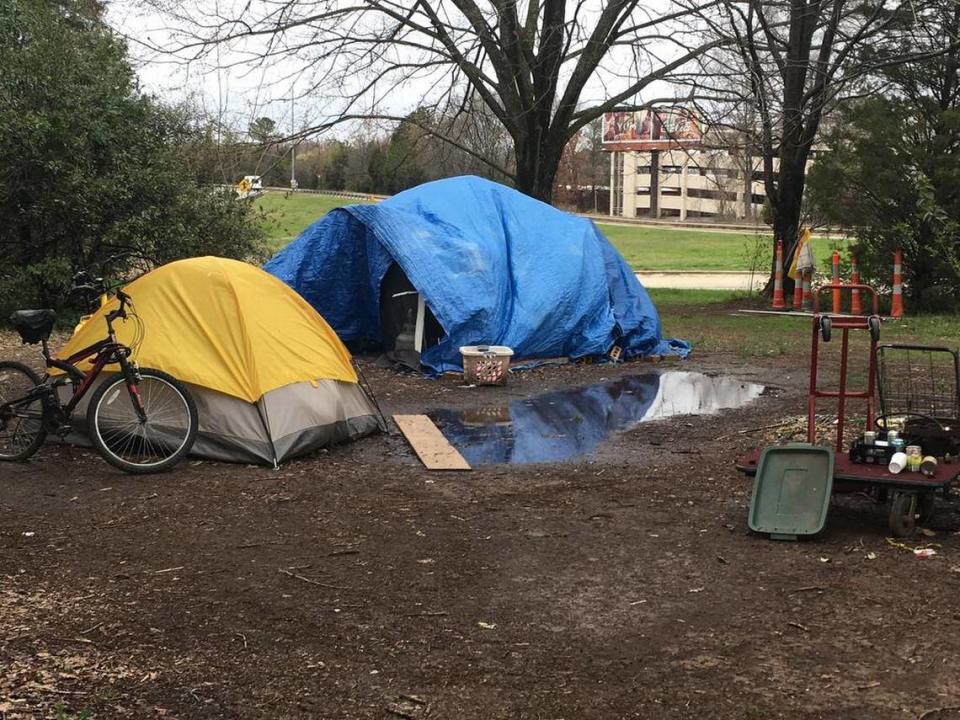I helped count Durham’s homeless population. Here’s what I saw.
There’s a fine line between hopefulness and helplessness, and I walked it all night Wednesday.
I was out in the rain with Housing for New Hope helping with the annual count of Durham’s homeless population.
We saw people tucked away in the woods where I’d never noticed people lived.
There was a trio of Spanish speakers behind a grocery store, laughing and friendly. A roofer lives there, so their structure has wooden walls.
Next door to a hotel notorious for overdose deaths and so brightly lit it hurt my eyes, a man marking his 63rd birthday.
At the tree line, he’s pinned a “Private Property” sign to an orange cone. His blue tarp-covered structure is only visible in the winter months, hidden by leaves and vines the rest of the year.
Behind self-storage units, there were tents and some sturdier structures surrounded by camp stoves, upturned crates and makeshift benches, and scattered heaps of trash.

Affordable housing crisis fuels homelessness
Housing for New Hope’s executive director Russell Pierce kicked off the night by acknowledging the numbers are up.
At last year’s count, 459 people were experiencing homelessness in Durham. That figure will likely be higher in 2023.
Pierce said staff saw a significant increase in outdoor encampments and families sleeping in their cars this year.
After a year of skyrocketing rent and inflation, he said, it makes sense.
The helpless feeling loomed.
But he was encouraged that community members are becoming increasingly active in helping their neighbors in need.
A week before the count, Housing for New Hope stopped taking volunteers because triple the typical number of counters had registered. There were 150 of us, split in teams of four and five and assigned a list of locations to survey.
Hopeful again.
How the homeless are counted
The federally mandated PIT count (point in time) happens every year at the end of January.
“Typically those are the coldest days of the year,” Shanta Addison said during my training session. “If you’re out there, you’ve likely exhausted all your resources.”
Our group visited six outdoor encampments along Holloway Street east of downtown. We interviewed two people so officials could better understand their circumstances and needs.
The questions begin simply: Age? Gender? Time spent unsheltered?
Then, they get deeply private: Do you abuse drugs or alcohol? Do you have a mental health problem? Do you have AIDS or an HIV-related illness?

We typed the answers into a cellphone app.
Both men were open and kind. They laughed when we asked their gender, and they said they struggled with alcoholism.
We saw eight people across the six sites, giving them blankets and bags of winter supplies.
I felt hopeful because most of the structures we encountered appeared remarkably sturdy, like they’d do a halfway decent job of keeping out the rain, wind and cold, but helpless when I imagined how deeply I’d struggle to winter in them anyway.
The annual counts provide a snapshot of data on those experiencing both unsheltered and sheltered homelessness.
Between 2016 and 2022, the number of unsheltered Durhamites jumped 292%. The number of people in shelters increased 24.5%.
I called around to Durham’s primary shelters the day after the count. Urban Ministries of Durham was full, but the Durham Rescue Mission, which has religious and work requirements, had beds to accommodate an additional 79 men, women and children.
Durham home to at least 100 homeless encampments
There are at least 100 encampments across Durham County, case manager Rebecca Bourgeois told our team, typically small groups of people tucked out of sight.
Helpless.
But there are caring folks keeping tabs on them and many Bull City residents trying to figure out how to get them into stable housing.
Our group also included a county commissioner, Wendy Jacobs; my friend Eliza Mathew, who sits on the Homeless Services Advisory Committee; Debra Clark Jones, who works at the juncture of Duke University’s health system and Office of Durham & Community Affairs; plus a public policy graduate student and a Durham police officer.
Each of us left with a few more dots connected on how we can best help and serve.
A more intimate awareness of what our homeless neighbors go through on wet winter nights.
And a better sense of what form solutions could take.
I went to bed on the hopeful side.
Are you concerned about someone living unsheltered? Contact (984) 358-1196 or email streetoutreach@housingfornewhope.org.

